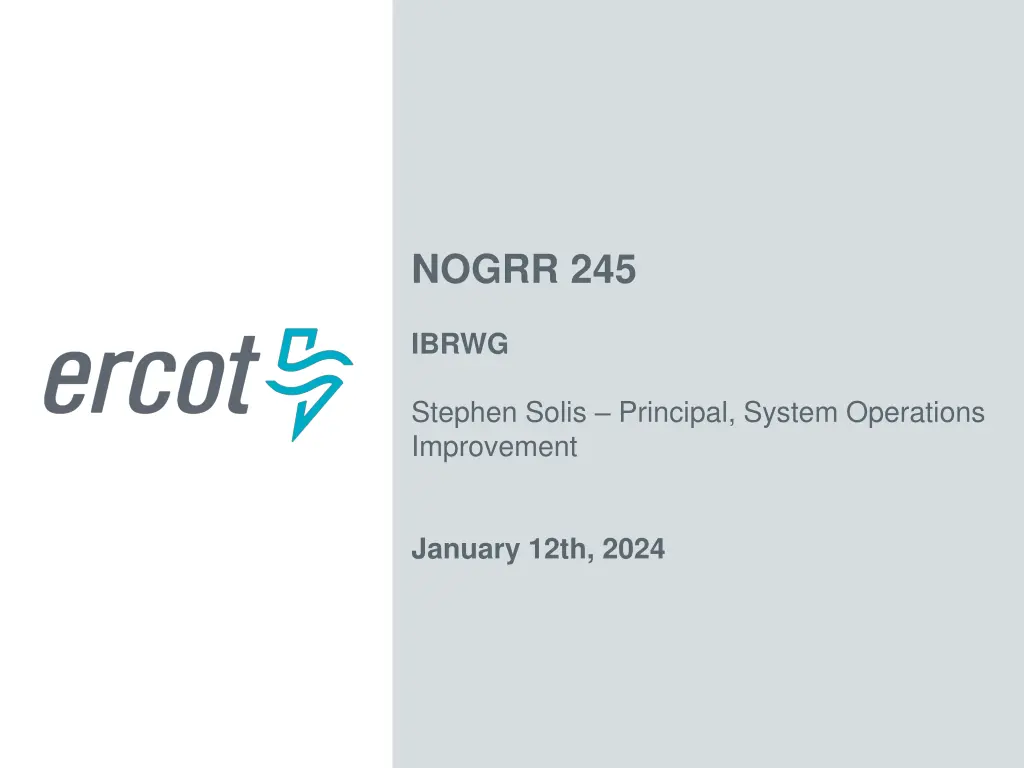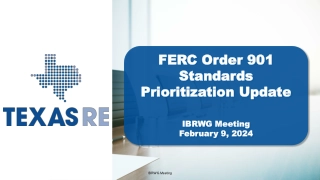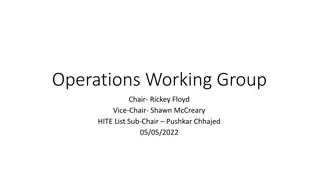
ERCOT Proposed Changes to NOGRR 245 - Technical Modifications Overview
Explore ERCOT's proposed changes to NOGRR 245, focusing on technical modifications, exceptions for documented technical limitations, requirements alignment, operational restrictions, and more. Stay informed about the evolving energy landscape in Texas.
Uploaded on | 1 Views
Download Presentation

Please find below an Image/Link to download the presentation.
The content on the website is provided AS IS for your information and personal use only. It may not be sold, licensed, or shared on other websites without obtaining consent from the author. If you encounter any issues during the download, it is possible that the publisher has removed the file from their server.
You are allowed to download the files provided on this website for personal or commercial use, subject to the condition that they are used lawfully. All files are the property of their respective owners.
The content on the website is provided AS IS for your information and personal use only. It may not be sold, licensed, or shared on other websites without obtaining consent from the author.
E N D
Presentation Transcript
NOGRR 245 IBRWG Stephen Solis Principal, System Operations Improvement January 12th, 2024
Update ERCOT has filed additional comments in on January 8th, 2024 with proposed additional modifications to the requirements that consider the technical feasibility of meeting the requirements as identified in the previously reviewed RFI results. Texas RE filed comments on January 11th, 2024 supportive of ERCOT s January 8th modifications. Jan 24, 2024 TAC Vote April 11, 2024 PUCT Vote Feb 27, 2024 ERCOT Board Vote 2 PUBLIC
ERCOT Proposed Changes to NOGRR 245 (1/8/24) Allows for additional exceptions for documented technical limitations Must meet existing requirements, and substantially meet new requirements, with each plant's documented technical limitation level becoming the requirement for that plant Must maximize capability through use of parameterization, software upgrades and minor hardware upgrade kits. ERCOT proposed a bright line criteria to not require hardware upgrades that exceed 20% of the replacement cost on a per turbine/inverter basis. Cannot create any instability, uncontrolled separation, or cascading outages for the ERCOT system Technical limitations must be accurately represented in all provided models Must meet latest requirements upon reinvestment (e.g., repower/retrofit requiring GIM process) Remove specificity and clarity requirements for legacy IBRs for RoCoF and Phase Angle Jump Return expectations around RoCoF and Phase Angle Jump requirements to status quo If voltage and frequency are within no trip zones, IBR must ride through Aligns with previous technical discussions that during transient, frequency and phase angle measurements are unreliable and IBR unit should not trip for these parameters during fault conditions. Modified multiple excursion requirement for legacy IBRs to maximize capability if they use a counter and ensure they can ride through normal TSP reclose schemes vs current alignment with IEEE 2800 Two major TSPs have indicated between 0 and 2 normal reclose attempts. ERCOT would consider a bright line criteria but would need TSPs to help identify such a criteria. 1st attempt is within 1 second 2nd attempt is between 10 and 20 seconds 3 PUBLIC
ERCOT Proposed Changes to NOGRR 245 Restored operational restrictions expectations for performance failures that pose significant reliability risk and cannot be implemented in reasonable time. Additional guardrails were proposed to limit the application of the restrictions to: When the actual or potential severity of the event on the ERCOT System is greater than the most severe single contingency. When the cause of the performance failure cannot be mitigated within 90 calendar days. When the location of the performance failure did affect or has the potential to materially affect known stability limitation on the ERCOT System When the IBR or WGR experience more than one failure in the prior 36 calendar months; or If the failure presents an imminent safety or equipment risk on the ERCOT system. Other clarifications/exceptions Handling of active current reductions during fault SGIA modifications for load-only additions would not trigger requirement to meet IEEE 2800 requirements if IBR does not need physical modifications to meet other requirements Additional extensions may be allowed for IBRs with SGIA after 6/1/23 and COD before 1/1/26 to meet requirements by 12/31/28 with documented limitations. Allows for new IBRs to have slower response times than required if needed for reliability purposes but clarifies that SSR Mitigation shall not depend on those slower recovery rates (i.e. if both the required response times and SSR Mitigation are needed, the IBR must provide SSR mitigation that does not depend on slowing down the response). 4 PUBLIC
Reliability Impact of ERCOT proposed exceptions Can move forward w/ OEM-identified parameterization and upgrade kits available from OEMs but that owners are waiting to authorize and procure "Technical Infeasibility" exemptions would not require consideration of very expensive upgrades such as repowers or converter replacements" Allows IBRs w/ SGIA beyond 6/1/23 with challenges to immediately meeting IEEE 2800 requirements to have a feasible path forward Reliability risk continues due to IBRs w/ exemptions Modeled limitations may impact stability limits Generic Transmission Constraints and its limits (GTLs) may be updated or added as needed. Impact of exceeding some GTLs may qualify them as an IROL Additional transmission projects may need to be implemented Some newly modeled limitations and repeated performance failures may require new credible contingencies (e.g., combined transmission and generator contingency) to be considered in both operations and planning May result in additional transmission congestion May create new voltage, cascading or instability conditions Key Takeaway: Proposed exemptions should help faster adoption of available improvements and IEEE 2800 but at expense of continued reliability risk and its associated impacts 5 PUBLIC
Additional assumptions IBR performance requirements are one part of overall solution to address risk IBR performance requirements (NOGRR 245) w/ appropriate enforcement System strength upgrades (e.g., 6 new synchronous condensers) Grid Forming capability adoption Modeling and testing improvements (DWG/IBRWG collaboration) Disturbance monitoring equipment installs (NOGRR 255) Potential planning criteria adjustments To offset risk, exemptions must be accompanied by: Clear expectations around potential operating restrictions for failures Models and contingencies accurately reflecting limitations Proper active and reactive power controls coordination The actions required to offset the risk could lead to additional operation and planning impact such as congestion and system improvements. Key Takeaway: Proposal assumes willingness to take on more reliability risk, that other risk offset activities will be adopted, and that other system cost impacts are acceptable to impacted entities. 6 PUBLIC
Questions? PUBLIC



